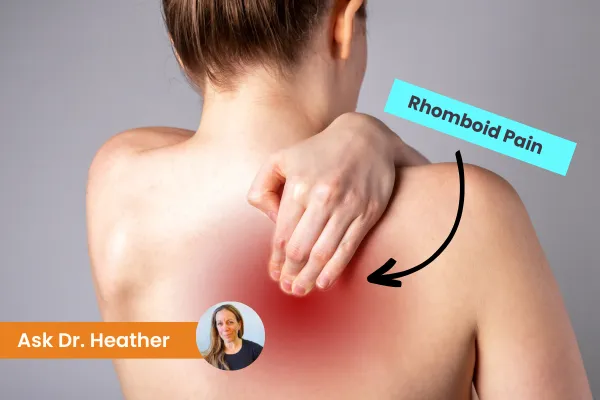Ask Doctor Heather Advice Corner

Relieving Rhomboid Pain: Tips, Stretches, and Exercises
Experiencing mid back pain, specifically behind the shoulder blade, can be excruciating and limit your daily activities. One common cause of such discomfort is rhomboid pain, which affects the muscles responsible for scapular movement. In this blog post, we will explore various methods to alleviate rhomboid pain, including lifestyle adjustments, stretches, and exercises. By addressing the root problem and incorporating these strategies into your routine, you can find relief from this type of pain quickly and effectively.
The rhomboid muscles are located beneath the shoulder blades and play a crucial role in scapular retraction and protraction. When these muscles become tight, they can cause irritation and discomfort in the mid back region. Prolonged sitting or engaging in activities that strain the rhomboids, such as weightlifting, can exacerbate the pain and hinder your daily functioning.

Quick Relief: Initial Steps to Ease Rhomboid Pain and Discomfort
When you first experience rhomboid pain, there are a few initial steps you can take to alleviate the discomfort. Applying ice to the affected area, using topical analgesics like Biofreeze, and massaging the region can help reduce inflammation and break down tension in the muscles. Additionally, evaluating your lifestyle factors, such as work ergonomics and sleep posture, is essential. Ensure your workstation is properly set up and invest in an ergonomic chair and supportive mattress. Making these adjustments can prevent further aggravation of the rhomboid area and enhance your overall comfort throughout the day.
Stretching Your Way to Relief: 6 Effective Stretches for Rhomboid Pain
To effectively address rhomboid pain, incorporating stretches and exercises into your routine is crucial. Here are some simple yet effective techniques:
Foam Roller Wall Stretch:
Place a long foam roller against the wall.
Position your hand on the roller, ensuring your shoulder blades have contact with it.
Roll the foam roller up the wall while dropping your head forward.
This stretch helps elongate the rhomboids, providing relief.
Cat-Cow Stretch:
Start on all fours with your hands and knees on the ground.
Arch your back upward, resembling a camel's hump (cow position).
Flatten your back, pushing your shoulder blades apart (cat position).
Repeat this gentle stretch to promote mobility and relieve tension.
Threading the Needle:
Begin on all fours, with your wrists aligned under your shoulders and knees under your hips.
Thread your right arm under your left arm, allowing your right shoulder to touch the ground.
Extend your left arm forward, stretching the rhomboid area on the right side.
Hold for a few seconds and repeat on the other side.
This stretch provides a deep release for the rhomboids.
Supine Spine Rotation:
Lie on your back and bring both knees toward your left side.
Place your arms palm to palm on the same side of your body.
Slowly rock your knees and arms to the right side, opening up your spine.
Return to the starting position and repeat on the other side.
This exercise helps release tension in the rhomboid area.
Scapular Wall Slides:
Stand against a wall with your forearms and upper arms in contact with the wall.
Slide your forearms upward and then downward, maintaining contact with the wall.
Aim for smooth and controlled movements.
This exercise improves scapular range of motion and strengthens the rhomboids.
Plank with Shoulder Blade Pinch:
Assume a plank position, keeping your core engaged.
Squeeze and pinch your shoulder blades together, activating the rhomboids.
Lift your hips slightly to maintain a straight line from your head to your heels.
Hold this position for 10-15 seconds, focusing on the contraction of the rhomboid muscles.
Repeat for multiple sets, gradually increasing the duration as your strength improves.
Note: It's important to start with gentle stretches and exercises and gradually increase the intensity and duration as your body becomes more accustomed to the movements. If you experience any pain or discomfort during these stretches and exercises, it's advisable to stop and consult with a healthcare professional.

Beyond Stretches: 5 Simple Tips for Rhomboid Pain Relief
Additional Tips for Rhomboid Pain Relief: In addition to stretches and exercises, implementing these lifestyle adjustments can further aid in relieving rhomboid pain:
Posture Correction: Pay attention to your posture throughout the day, whether you're sitting, standing, or walking. Maintain an upright position, with your shoulders relaxed and your spine aligned.
Regular Breaks: If you have a sedentary job or engage in activities that require prolonged sitting or repetitive movements, take regular breaks to stretch and move around. This helps prevent muscle stiffness and tension buildup.
Strength Training: Strengthening the muscles surrounding the rhomboids, such as the upper back and shoulder muscles, can provide support and reduce strain on the rhomboids. Incorporate exercises like rows, pull-ups, and shoulder presses into your workout routine.
Heat Therapy: Applying a heat pack or taking a warm shower can help relax the rhomboid muscles and alleviate pain. Use heat therapy in conjunction with stretches and exercises for enhanced relief.
Professional Help: If the pain persists or worsens despite trying these self-care measures, it's advisable to seek professional help. A physical therapist or chiropractor can provide targeted treatments, such as manual therapy, dry needling, or spinal adjustments, to address the underlying issues causing rhomboid pain.
Rhomboid pain can be debilitating, but with a comprehensive approach that includes stretches, exercises, and lifestyle adjustments, relief is attainable. Be consistent with your self-care routine and listen to your body's signals to avoid overexertion or exacerbating the pain.
Remember to consult with a healthcare professional if the pain persists or if you have any concerns. By addressing the root causes and incorporating these strategies, you can find lasting relief and regain your mobility and comfort.
Discover the hidden secrets to finally conquering low back pain with our exclusive online course. This comprehensive program equips you with all the essential tools needed to achieve a pain-free life. Step-by-step instructional videos led by renowned expert Dr. Heather will guide you through proven methods for eliminating your low back pain once and for all. Dr. Heather's expertise will educate and empower you, providing invaluable insights and techniques to help you experience true freedom from pain.
Best of all, the course requires minimal equipment, such as a therapy ball/exercise ball and a BOSU, to perform intermediate and advanced exercises.
Don't miss out on this transformative opportunity to reclaim your comfort and vitality. Enroll in our course today!






